CORPORATE GOVERNANCE & RISK TRANSFER: A SURVEY ON PERCEPTIONS OF WOMEN LEADERS IN THE NATIONAL CAPITAL REGION (NCR) BY BIMTECH & RAHEJA QBE GENERAL INSURANCE CO. LTD.
“Diversity & Inclusivity :Risk to ignore at your own peril! ”
Mr. Praveen Gupta CEO, Raheja QBE General Insurance
The biggest common underlying risk – both societal and economic to the world’s oldest ‘melting pot’ where diversity has kept diversifying in the last 5000 years – is the insensitivity towards inclusivity. The voices the BIMTECH team attempted to unearth from a specific geography only vindicate this. Basis the findings, we reached out to women leaders of eminence to seek their perspectives. The study also captures the pearls shared by the leaders. We believe these also constitute a significant risk management protocol on D&I for any well intentioned corporate wishing to de-risk its culture. – Mr. Praveen Gupta, MD & CEO Raheja QBE General Insurance Co. Ltd.
 Prof. (Dr.) Abhijit K Chattoraj
Professor & Chairperson-PGDM-(Insurance Business Management)-IBM,
BIMTECH.
The research was conceived and executed by Mr. Praveen Gupta, MD & CEO Raheja QBE General Insurance Co. Ltd , Prof. (Dr.) Abhijit K Chattoraj, Professor & Chairperson-PGDM-(Insurance Business Management)-IBM, Birla Institute of Management Technology (BIMTECH) and students of IInd year -PGDM – IBM
Prof. (Dr.) Abhijit K Chattoraj
Professor & Chairperson-PGDM-(Insurance Business Management)-IBM,
BIMTECH.
The research was conceived and executed by Mr. Praveen Gupta, MD & CEO Raheja QBE General Insurance Co. Ltd , Prof. (Dr.) Abhijit K Chattoraj, Professor & Chairperson-PGDM-(Insurance Business Management)-IBM, Birla Institute of Management Technology (BIMTECH) and students of IInd year -PGDM – IBM
Overview Rationale For ages men have been holding/occupying top corporate positions but in the last two decades we have seen a slow but steady rise of women in these roles. Even though men continue to constitute a very high percentage of the workforce and almost monopolise leadership positions, every industry is beginning to recognise the contribution of women leaders. In this joint project of Insurance Business Management, BIMTECH and Raheja QBE General Insurance Company Ltd, basis the survey carried out analyse the risks faced by women leaders across the entire spectrum of businesses in the National Capital Region (NCR). An attempt has been made to understand their views on gender inequality, its prevalence and awareness on various aspects of risk management including risk transfer. The starting point was top leadership roles in the public and private sectors. Given the lukewarm response it was decided to expand the scope of this study. Needless to mention that as a country we are a “United States of India”, perhaps the world’s oldest melting pot – with a significant variation in culture and practices across its length and breadth. Views of three experts were sought. Ms. Sonu Bhasin a corporate leader, much sought after independent director and author of The Inheritors: Stories of Entrepreneurship and Success; Ms. Suman Joshi a Diversity & Inclusion expert with over three decades of HR leadership particularly in the ITES sector predominantly out of South India and Ms. Carissa Hickling a Canadian by birth who has for last three decades made India her home. Carissa currently leads a global talent management role for Siemens, based out of Mumbai. Those get woven here to bring about the multiplicity of nuances in play. Rather than just presenting an isolated parochial set of findings. Who were reached out to?
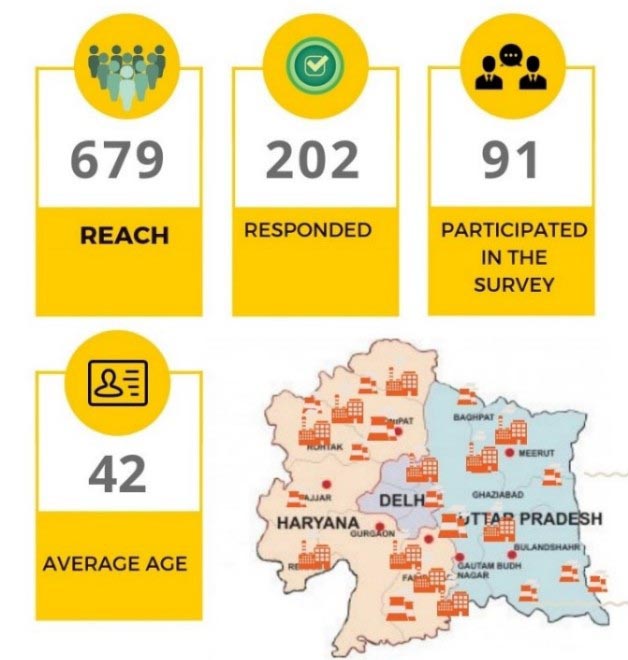 Corporate India: Backgrounder
When the Companies Act mandated one woman on each board, things did not begin to happen on their own. Blessed by the stock market regulator, the Securities & Exchanges Board of India (SEBI), the Women on Corporate
Boards (WCB) Mentorship Program aims to enhance the gender balance and increase the effectiveness of corporate boards. A unique voluntary programme – one of its kind in the world – it genuinely fosters mentoring, passing on valuable corporate governance experience from experienced board members to women leaders starting their board career.
Together with the WCB, information management specialist Institutional Investor Advisory Services (IIAS) no too long ago released a report, titled Corporate India: Women On Boards. The IIAS is a SEBI-registered proxy advisory firm. While limited to Nifty 500 companies, the study is a kind of performance report on their evolving diversity.
Emerging trends: good news!
Corporate India: Backgrounder
When the Companies Act mandated one woman on each board, things did not begin to happen on their own. Blessed by the stock market regulator, the Securities & Exchanges Board of India (SEBI), the Women on Corporate
Boards (WCB) Mentorship Program aims to enhance the gender balance and increase the effectiveness of corporate boards. A unique voluntary programme – one of its kind in the world – it genuinely fosters mentoring, passing on valuable corporate governance experience from experienced board members to women leaders starting their board career.
Together with the WCB, information management specialist Institutional Investor Advisory Services (IIAS) no too long ago released a report, titled Corporate India: Women On Boards. The IIAS is a SEBI-registered proxy advisory firm. While limited to Nifty 500 companies, the study is a kind of performance report on their evolving diversity.
Emerging trends: good news!
- The telecoms, IT, healthcare, utilities and industrial sectors have a higher than average proportion of women directors, with the energy sector at the lowest end on 8.9%.
- Average tenure on boards for women directors has been 4.6 years, compared to a much higher tenure of 9.0 years for male directors. This is largely due to the fact that many women directors came onto the board only after the Companies Act 2013 came into effect.
- A large majority of companies (485) are compliant with regulatory thresholds. Some 107 companies have exceeded the quota of one-woman director on the board and four companies had four women directors on their board.
- Fifteen companies in the study did not have a woman director on the board on 31 March 2017. Of those, 11 are public sector undertakings (PSU), where the appointment process is delayed due to pending approvals from the relevant ministry.
- In widely-held companies where there is no discernible promoter or promoter entity, the proportion of woman directors is the highest at 14.3%. This is not surprising, considering that most of these companies are from financial services, with high institutional ownership. Once again, PSUs trail behind, with only 11.9% female representation.
- There are only 98 promoter women directors (16%) in the NIFTY 500. Of this set, 50% are executives and are driving the company in a leadership capacity. The report highlights that the latest data invalidates any concerns that a sizeable portion of new women directors belong to the promoter family and are being appointed in a non-executive capacity just to comply with the regulations.
- This implies that bulk of the women getting appointed have professional experience and expertise – which suggests companies are not paying mere lip service to the regulations by promoting family members but have internalised the legislative intent of the mandated thresholds.
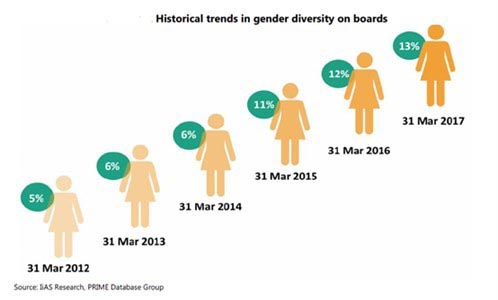 Where is India lagging ?
Just 3% of boards are headed by women (as chairperson) and women directors now account for 7% of executive directorships in the NIFTY 500. This is comparable to European markets, where 4% of chairpersons and 7% of executive directors are women. But where India falls behind is independent representation – only 16% of independent directors in India are women, compared to 34% in the STOXX Europe 600 Index.
Only 21% of NIFTY 500 boards have two or more women, compared to more than 80% in some other markets. On average, India has 1.2 women directors on boards, which is significantly less than its European and US peers. Even on committee memberships, women directors are under represented in India.
What next?
The report recognises that India is one of the first developing countries to have enforced a quota of at least one woman director on the board, under the legal framework. Thanks to this push, female representation in the NIFTY 500 has gone up from a low 5% in 2012 to 13% by 31 March 2017. However, the report sets the bar higher, proposing the following targets:
Where is India lagging ?
Just 3% of boards are headed by women (as chairperson) and women directors now account for 7% of executive directorships in the NIFTY 500. This is comparable to European markets, where 4% of chairpersons and 7% of executive directors are women. But where India falls behind is independent representation – only 16% of independent directors in India are women, compared to 34% in the STOXX Europe 600 Index.
Only 21% of NIFTY 500 boards have two or more women, compared to more than 80% in some other markets. On average, India has 1.2 women directors on boards, which is significantly less than its European and US peers. Even on committee memberships, women directors are under represented in India.
What next?
The report recognises that India is one of the first developing countries to have enforced a quota of at least one woman director on the board, under the legal framework. Thanks to this push, female representation in the NIFTY 500 has gone up from a low 5% in 2012 to 13% by 31 March 2017. However, the report sets the bar higher, proposing the following targets:
- To ensure boards have at least one woman independent director in the next 18 months.
- To achieve 20% female representation by 2020.
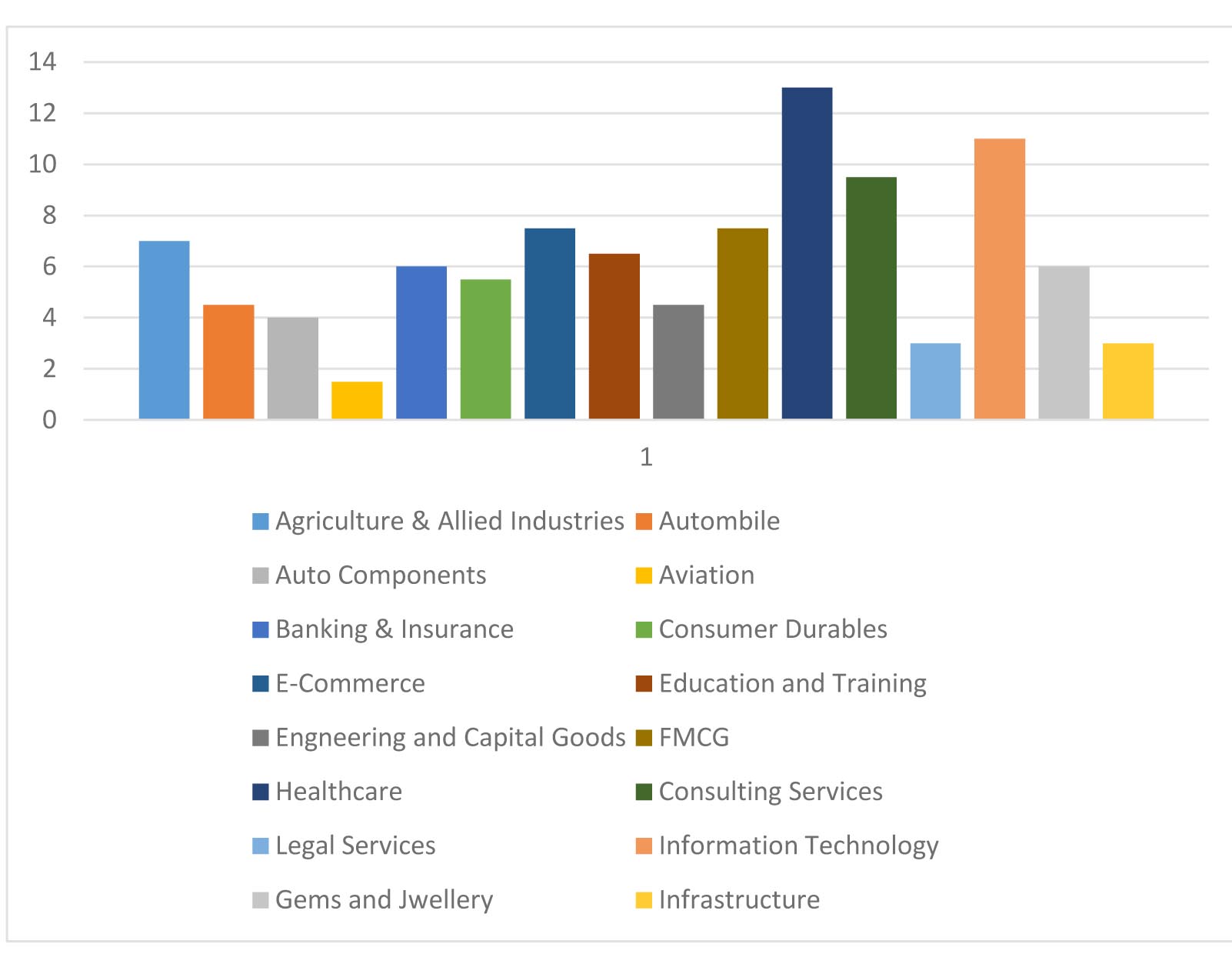
- To ascertain whether they faced gender inequality in their line of business.
- To determine activities which promote the cause of environment, society, governance (ESG) and employee retention?
- To understand the nature and gamut of varied dimensions of risk vis-a-vis women corporate leaders.
- To ascertain whether corporate woman leaders comprehend the implications of various liability risk transfer solutions available in the market.
- There is no gender inequality felt by the women corporate leaders.
- Corporate decisions do not hinder the governance, the course of environment and the growth of employee relations.
- Most corporate women leaders are aware of varied risks faced by them.
- Most leaders understand the implications of various liability risk transfer solutions available in the market.
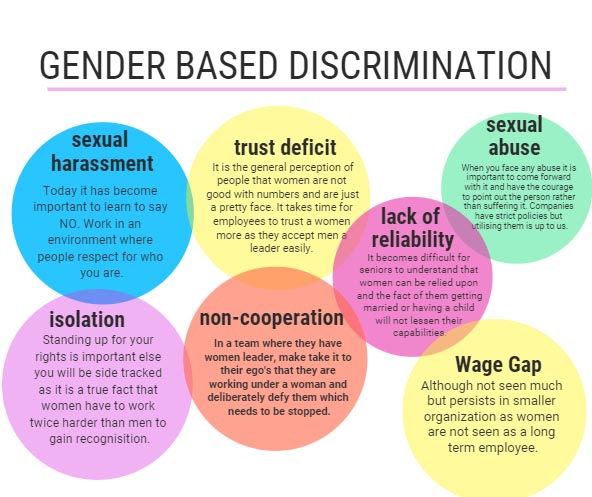 Sexual Abuse: Causing mental trauma to a woman by practicing inappropriate behaviour which is against the consent of the person and includes sexist gestures which may include inappropriate physical contact.
62 out of 86 interviewees confessed that they were sexually abused at work.
Lack of Reliability: Lack of trust or being dependable in achievement of organisational goals basis the gender.
60 interviewees believed that they were considered less reliable as compared to their male colleagues.
Non-cooperation: Failure or refusal to cooperate, especially as a form of non-participation or disobeying tasks given to employees, as the male employee feels taking orders from a woman is not worth.
According to 65 interviewees, their male colleagues were non-cooperative with them at work.
Isolation: Not including in the official activities, major decision making and structural roles or making a woman feel invisible when she makes changes or suggestions with respect to the leadership position she holds.
According to 64 interviewees, their male colleagues made them feel invisible at work and as a result they felt isolated.
Wage Gap: Difference in wages given to men and women for the same role
According to 53 interviewees, male employees are given more salaries and benefits than female employees.
Sexual Abuse: Causing mental trauma to a woman by practicing inappropriate behaviour which is against the consent of the person and includes sexist gestures which may include inappropriate physical contact.
62 out of 86 interviewees confessed that they were sexually abused at work.
Lack of Reliability: Lack of trust or being dependable in achievement of organisational goals basis the gender.
60 interviewees believed that they were considered less reliable as compared to their male colleagues.
Non-cooperation: Failure or refusal to cooperate, especially as a form of non-participation or disobeying tasks given to employees, as the male employee feels taking orders from a woman is not worth.
According to 65 interviewees, their male colleagues were non-cooperative with them at work.
Isolation: Not including in the official activities, major decision making and structural roles or making a woman feel invisible when she makes changes or suggestions with respect to the leadership position she holds.
According to 64 interviewees, their male colleagues made them feel invisible at work and as a result they felt isolated.
Wage Gap: Difference in wages given to men and women for the same role
According to 53 interviewees, male employees are given more salaries and benefits than female employees.
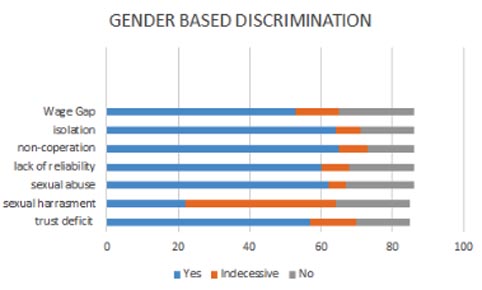 2. Work Ethics: There are findings basis questions asked on work ethics and management skills:
Networking: Making corporate relations, for instance, staying with colleagues half an hour after the office hours rather than rushing home.
According to 82 interviewees, networking or building connections is the key to survive in the corporate world. Day to day work becomes much easier and effortless if one has good and stable relationship with other employees.
Multi-tasking: The ability to handle more than one project at a time. It is not restrained to being able to handle home and office.
All the interviewees believed that you must be good at multitasking in order to move up the corporate ladder. If one is not good at multitasking than one could become dead wood.
Importance of acknowledging others: It is related to ability to give due credit to the team and members. Appreciating the work for individuals and acknowledging them.
According to 84 interviewees, it is very important to acknowledge others at work as it strengthens relationships between employees.
Thoughts on success: It is related to mindset, as to how success comes to a woman. Is it same as that for the other gender, or is it harder to earn?
According to all the interviewees, success is always hard earned. It takes a lot of effort and perseverance to be successful in life.
Thoughts on women safety: It is not only restricted to understanding the importance of women safety but also the proactive steps taken by the women for making the workplace better and safer.
According to 84 interviewees, women safety in India is very poor and serious steps or measures should be taken to improve the same. This will further promote female education and female employment and will make our society a better place to live.
Second Guess: Rethinking on themselves as being capable of worthy of taking a position or role before getting the role.
80 interviewees accepted that they tend to rethink about the situations before taking major decisions.
Corporate Social Responsibility: Believing in the importance of CSR and making efforts towards improvement of the society.
73 interviewees have worked towards corporate social responsibility and consider it a great opportunity for contributing towards the society and improving their company’s brand value.
Thoughts on negotiation: Negotiating for their positions or benefits which they rightfully hold and are not getting them.
81 interviewees believe that in order to maintain peace and harmony at work, it is important to negotiate.
Balance between personal and professional life: Ability to achieve work life balance.
According to 84 interviewees, a balance between personal and professional life should always be maintained as it improves the efficiency at work and enjoy life at the same time.
Reducing Attrition Rate: Any effort or special steps taken by them as leaders to reduce attrition?
According to 77 interviewees, they have taken certain steps to reduce attrition rate. They try to become more flexible at meeting their targets by opting for in-house working schedules.
3. Risk Analysis: Various questions were asked as to how they access their risks and the steps taken to mitigate the risks at work:
SWOT Analysis: Identifying the strengths and weaknesses of the organisation through SWOT analysis or other similar techniques.
79 interviewees had no idea about their risks and had never undertaken SWOT analysis of their risks.
2. Work Ethics: There are findings basis questions asked on work ethics and management skills:
Networking: Making corporate relations, for instance, staying with colleagues half an hour after the office hours rather than rushing home.
According to 82 interviewees, networking or building connections is the key to survive in the corporate world. Day to day work becomes much easier and effortless if one has good and stable relationship with other employees.
Multi-tasking: The ability to handle more than one project at a time. It is not restrained to being able to handle home and office.
All the interviewees believed that you must be good at multitasking in order to move up the corporate ladder. If one is not good at multitasking than one could become dead wood.
Importance of acknowledging others: It is related to ability to give due credit to the team and members. Appreciating the work for individuals and acknowledging them.
According to 84 interviewees, it is very important to acknowledge others at work as it strengthens relationships between employees.
Thoughts on success: It is related to mindset, as to how success comes to a woman. Is it same as that for the other gender, or is it harder to earn?
According to all the interviewees, success is always hard earned. It takes a lot of effort and perseverance to be successful in life.
Thoughts on women safety: It is not only restricted to understanding the importance of women safety but also the proactive steps taken by the women for making the workplace better and safer.
According to 84 interviewees, women safety in India is very poor and serious steps or measures should be taken to improve the same. This will further promote female education and female employment and will make our society a better place to live.
Second Guess: Rethinking on themselves as being capable of worthy of taking a position or role before getting the role.
80 interviewees accepted that they tend to rethink about the situations before taking major decisions.
Corporate Social Responsibility: Believing in the importance of CSR and making efforts towards improvement of the society.
73 interviewees have worked towards corporate social responsibility and consider it a great opportunity for contributing towards the society and improving their company’s brand value.
Thoughts on negotiation: Negotiating for their positions or benefits which they rightfully hold and are not getting them.
81 interviewees believe that in order to maintain peace and harmony at work, it is important to negotiate.
Balance between personal and professional life: Ability to achieve work life balance.
According to 84 interviewees, a balance between personal and professional life should always be maintained as it improves the efficiency at work and enjoy life at the same time.
Reducing Attrition Rate: Any effort or special steps taken by them as leaders to reduce attrition?
According to 77 interviewees, they have taken certain steps to reduce attrition rate. They try to become more flexible at meeting their targets by opting for in-house working schedules.
3. Risk Analysis: Various questions were asked as to how they access their risks and the steps taken to mitigate the risks at work:
SWOT Analysis: Identifying the strengths and weaknesses of the organisation through SWOT analysis or other similar techniques.
79 interviewees had no idea about their risks and had never undertaken SWOT analysis of their risks.
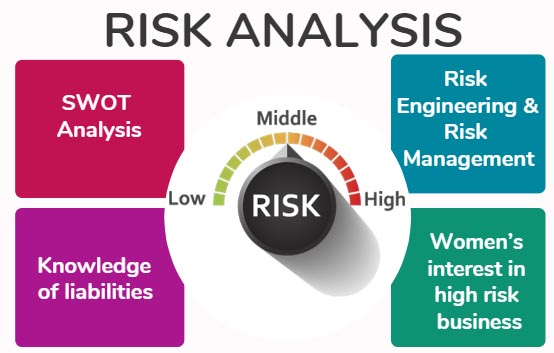 Risk Engineering and Risk Management: Compliance with various risk mitigation techniques in-order to reduce the risk adversities that might be faced by an organisation.
82 interviewees had never taken services related to risk engineering or risk management.
Women’s interest in high risk business: Women have a tendency to be averse to business propositions that are prone to greater risk.
According to 72 interviewees, women get involved in low risk businesses as it ensures stability.
Knowledge of liabilities: Women leaders are aware of the liabilities that come as a part with their position that they hold in the organization
76 interviewees had very less knowledge of liabilities with respect to their position or designation.
Risk Engineering and Risk Management: Compliance with various risk mitigation techniques in-order to reduce the risk adversities that might be faced by an organisation.
82 interviewees had never taken services related to risk engineering or risk management.
Women’s interest in high risk business: Women have a tendency to be averse to business propositions that are prone to greater risk.
According to 72 interviewees, women get involved in low risk businesses as it ensures stability.
Knowledge of liabilities: Women leaders are aware of the liabilities that come as a part with their position that they hold in the organization
76 interviewees had very less knowledge of liabilities with respect to their position or designation.
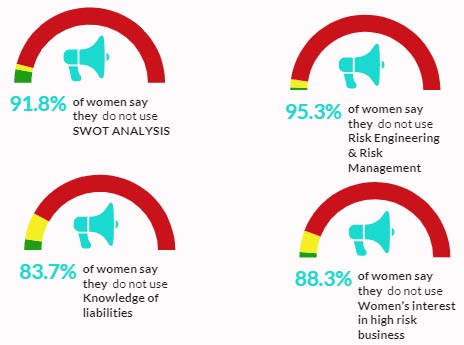 4. Risk mitigation through insurance: The interviewees were asked about insurance and its role in risk mitigation:
4. Risk mitigation through insurance: The interviewees were asked about insurance and its role in risk mitigation:
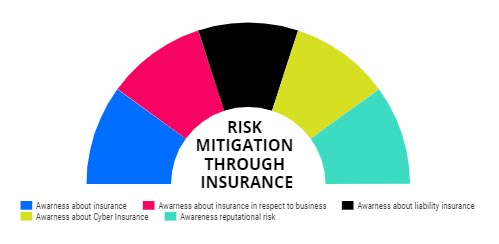 Insurance Awareness: Awareness about the various insurance solutions available in the market.
84 interviewees were aware of insurance and major lines of insurance business- life insurance, health insurance and property insurance in particular.
Insurance awareness related to business: Awareness about the various insurance solutions that protect the interest of an enterprise against the risks faced.
74 interviewees had partial knowledge or awareness of insurance solutions related to their respective businesses.
Awareness of liability insurance: Awareness about the various liability insurance offerings that help in protecting the interest of the enterprise.
79 interviewees had no clue about liability insurance and its significance in risk mitigation.
Insurance Awareness: Awareness about the various insurance solutions available in the market.
84 interviewees were aware of insurance and major lines of insurance business- life insurance, health insurance and property insurance in particular.
Insurance awareness related to business: Awareness about the various insurance solutions that protect the interest of an enterprise against the risks faced.
74 interviewees had partial knowledge or awareness of insurance solutions related to their respective businesses.
Awareness of liability insurance: Awareness about the various liability insurance offerings that help in protecting the interest of the enterprise.
79 interviewees had no clue about liability insurance and its significance in risk mitigation.
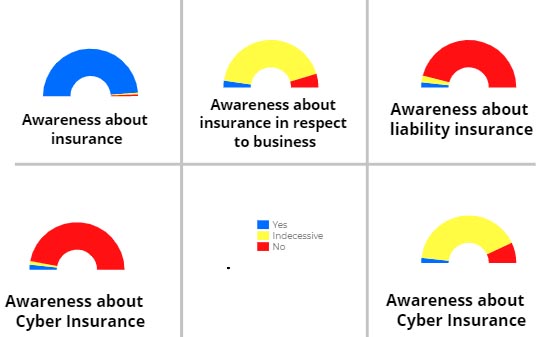 Awareness of cyber insurance:
81 interviewees had no clue about cyber insurance and its increasing significance in businesses including technology.
Awareness of reputational risks: Awareness about reputational risks to both the organization and individual and its concerned repercussions.
71 interviewees were not sure whether they are fully aware of reputational risks or not and the extent to which it could damage their business.
5. The Voices: Anonymous & otherwise:
“I have seen women hesitate to take a risk because they fear failure. That’s a strong factor that comes in their way to success”.
Entrepreneurship is hard, for men and women alike: “Struggle with funding, scaling up, compliances and finding the right talent to make your dream profitable is always a challenge.”
The challenges as a young female entrepreneur in a male-dominated and somewhat patriarchal industry: “I had to struggle moving from ‘just a young woman with a fancy degree’ to earning respect as a ‘businesswoman’. The best way to overcome this was not to take it personally but gain the respect and trust by letting my work speak for itself”.
Pregnancy can create many issues as well. Three ways to help in overcoming or addressing this challenge:
Awareness of cyber insurance:
81 interviewees had no clue about cyber insurance and its increasing significance in businesses including technology.
Awareness of reputational risks: Awareness about reputational risks to both the organization and individual and its concerned repercussions.
71 interviewees were not sure whether they are fully aware of reputational risks or not and the extent to which it could damage their business.
5. The Voices: Anonymous & otherwise:
“I have seen women hesitate to take a risk because they fear failure. That’s a strong factor that comes in their way to success”.
Entrepreneurship is hard, for men and women alike: “Struggle with funding, scaling up, compliances and finding the right talent to make your dream profitable is always a challenge.”
The challenges as a young female entrepreneur in a male-dominated and somewhat patriarchal industry: “I had to struggle moving from ‘just a young woman with a fancy degree’ to earning respect as a ‘businesswoman’. The best way to overcome this was not to take it personally but gain the respect and trust by letting my work speak for itself”.
Pregnancy can create many issues as well. Three ways to help in overcoming or addressing this challenge:
- Have a clear winning attitude
- Believe that this is addressable with little to no compromise. Makes you solution-oriented rather than defensive or apologetic. As you become more objective and clear in articulation, it becomes easier for spouse and family to sign in and co-own the solution.

Published : The Insurance Times – December, 2018





Leave a Reply